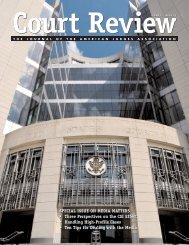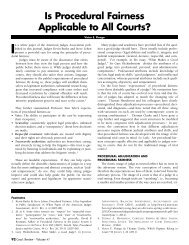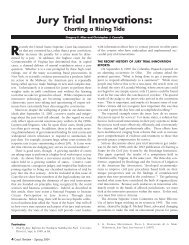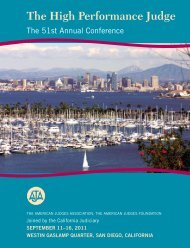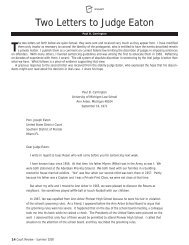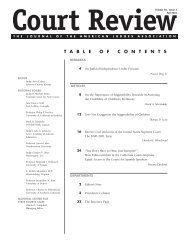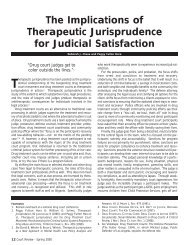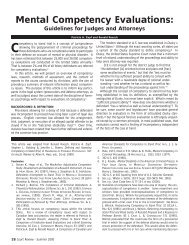Special Issue on Procedural Fairness - American Judges Association
Special Issue on Procedural Fairness - American Judges Association
Special Issue on Procedural Fairness - American Judges Association
- No tags were found...
Create successful ePaper yourself
Turn your PDF publications into a flip-book with our unique Google optimized e-Paper software.
PERCEPTIONS OF PROCEDURAL FAIRNESS DIFFER DRAMATICALLYAMONG MINORITY AND MAJORITY POPULATIONS.Awide divisi<strong>on</strong> exists am<strong>on</strong>g different minority populati<strong>on</strong>s in the frequency withwhich people express approval of the court system. Asian populati<strong>on</strong>s generallyhold significantly higher approval ratings for the judicial branch than doHispanics, African <strong>American</strong>s, or even Caucasians. 60 However, when asked about theprobability of fair outcomes in court, all of these major ethnic groups “… perceive ‘worseresults’ in outcomes for African-<strong>American</strong>s, low-income people, and n<strong>on</strong>-English speakers.”61 It is troubling that a wide c<strong>on</strong>sensus believes these groups c<strong>on</strong>sistently receive lessfair outcomes.As a group, African <strong>American</strong>s feel that they receive less fair outcomes in their cases.When compared to Hispanics and Caucasians, 70% of African <strong>American</strong>s believe that theyare treated “somewhat” or “far” worse. African <strong>American</strong>s are also two times more likelyto believe that a court’s outcome will “seldom” or “never” be fair as they would believe thatthe outcome will “always” or “usually” be fair. 62 Further, African-<strong>American</strong> defendantswho enter the courtroom “report worse treatment, more negative outcomes, lower percepti<strong>on</strong>sof the quality of the court’s decisi<strong>on</strong>-making process, and less trust in the motivesof court actors. After the case is decided, these negative percepti<strong>on</strong>s translate into less satisfacti<strong>on</strong>with the court overall and less acceptance of the court’s decisi<strong>on</strong>, all of which inturn lower compliance” 63 It’s little w<strong>on</strong>der that these attitudes negatively impact recidivism.And these percepti<strong>on</strong>s may well be reality-based: though true apple-to-apple casecomparis<strong>on</strong>s are difficult to make, African <strong>American</strong>s are 4.8 times more likely to be incarceratedand are generally given much harsher sentences than white defendants. 64While people with different ethnic and racial backgrounds differ in the degree to whichthey have trust and c<strong>on</strong>fidence in the legal system, people are c<strong>on</strong>cerned about fair proceduresirrespective of their ethnicity and ec<strong>on</strong>omic status and are willing to defer to acourt’s judgment if procedural fairness exists. 65 <strong>Procedural</strong> fairness is the primary factorthat shapes percepti<strong>on</strong>s of the judicial system. 66 However, since African <strong>American</strong>s perceiveless fairness, it is critical to focus <strong>on</strong> what alleviates or aggravates that difference.Interestingly, “[d]efendants at Red Hook were not <strong>on</strong>ly more generally satisfied thanthose at the traditi<strong>on</strong>al court, but there was less variati<strong>on</strong> by race and socioec<strong>on</strong>omic status.”67 The Red Hook Community Court in Brooklyn seems to have eliminated the distincti<strong>on</strong>sbetween perceived levels of fairness am<strong>on</strong>g ec<strong>on</strong>omic and ethnic divisi<strong>on</strong>s. Thisis of paramount importance because of the dem<strong>on</strong>strated and pervasive level of distrustof the judicial system am<strong>on</strong>g African <strong>American</strong>s; “[i]f community courts neutralize thiseffect, they make an important c<strong>on</strong>tributi<strong>on</strong> to improving the legitimacy of the court inthe eyes of a populati<strong>on</strong> disproporti<strong>on</strong>ately affected by the criminal justice system.” 6860. Rottman 2005, supra note 21, at 8.61. Id. at 30.62. Frazer, supra note 4, at 4.63. Id.64. Id.65. Tom R. Tyler, What Do They Expect? New Findings C<strong>on</strong>firm thePrecepts of <strong>Procedural</strong> <strong>Fairness</strong>, CALIF. CTS. REV., Winter 2006, at23.66. Tom R. Tyler, Governing Amid Diversity: Can Fair Decisi<strong>on</strong>-MakingProcedures Bridge Competing Public Interests and Values?, 28 LAW &SOC’Y REV. 701 (1994); Tom R. Tyler, Multiculturalism and theWillingness of Citizens to Defer to Law and Legal Authorities, 25LAW & SOC. INQUIRY 983 (2000); Tom R. Tyler, Public Trust andC<strong>on</strong>fidence in Legal Authorities: What Do Majority and MinorityGroup Members Want from Law and Legal Authorities?67. Frazer, supra note 4, at IV.68. Id. at 27.Court Review - Volume 44 17



